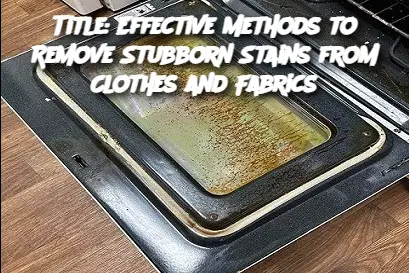-
Identify the Stain Type: Before applying any treatments, determine what caused the stain. Different stains require different approaches. For instance, oil-based stains (like grease or makeup) respond best to dish soap or baking soda, while water-based stains (like coffee or wine) may be best treated with vinegar or hydrogen peroxide.
-
Act Quickly: The sooner you address the stain, the better. Blot the stained area with a clean cloth to remove as much of the substance as possible. Avoid rubbing, as it can push the stain deeper into the fabric fibers.
-
Test First: For delicate fabrics, always test a small amount of the stain remover in an inconspicuous area to ensure it won’t damage or discolor the fabric.
-
Apply the Stain Remover: Depending on the stain and the solution you’re using, apply the appropriate amount directly to the stained area. Let it sit for at least 10 minutes, but for tougher stains, you may need to leave it on longer.
-
Launder as Usual: After letting the stain remover sit, launder the item as you normally would, but be sure to check if the stain is fully gone before putting it in the dryer. The heat from the dryer can set the stain, making it more difficult to remove.
Serving and Storage Tips:
- Act Fast: The sooner you treat a stain, the better your chances of completely removing it. Even if you’re not able to treat the stain immediately, try to blot and rinse the area with cold water until you can address it properly.
- Avoid Using Heat: If the stain isn’t completely gone, don’t dry the fabric until you’ve successfully removed the stain. Heat can make certain stains permanent.
- Keep Stain Removers Handy: Having a few basic cleaning ingredients like dish soap, vinegar, and baking soda on hand will allow you to treat stains right away, reducing the chances of a permanent mark.
Variants:
- For Ink Stains: Use rubbing alcohol or a mixture of dish soap and vinegar to break down the ink. Apply directly to the stained area, then blot and rinse with cold water.
- For Blood Stains: Hydrogen peroxide works wonders on blood stains. Apply directly, let it bubble up, then gently blot it away with a clean cloth.
- For Wine Stains: Pour white wine or club soda on the stain immediately to dilute it, then treat with a solution of dish soap and warm water.
FAQ:
Q: Can I remove a stain after it has already dried? A: It’s more challenging to remove a dried stain, but it’s still possible. Reapply the appropriate stain remover and let it sit longer. You may need to repeat the process a few times for stubborn stains.
Q: Should I always use cold water for stains? A: For most stains, cold water is recommended, especially if you’re dealing with protein-based stains like blood or dairy. However, some stains, like grease or oil, may require warm water to effectively break them down.
Q: What if the stain doesn’t come out after washing? A: Don’t put the item in the dryer if the stain persists, as heat can set it. Instead, reapply the stain remover and wash the item again. If the stain is still there, consider seeking professional cleaning services, especially for delicate fabrics.
By following these tips and using the right ingredients for the job, you can tackle even the most stubborn stains and keep your clothes looking like new!
